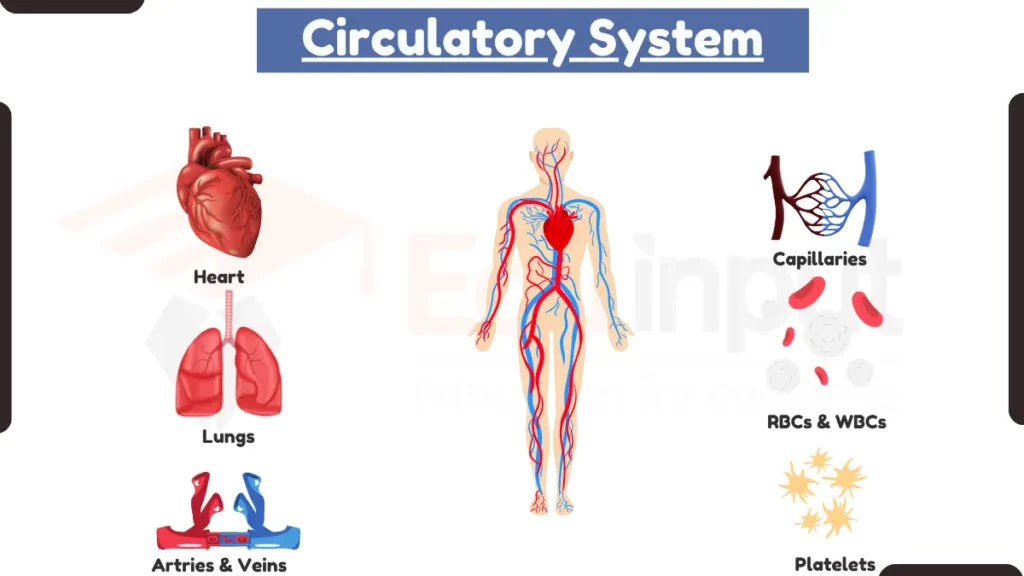Circulatory System – Anatomy, Types, and Functions
The circulatory system is a network of blood vessels that transports blood throughout the body. Blood carries oxygen, nutrients, hormones, and waste products to and from all cells in the body. The circulatory system is essential for life, and any problems with it can lead to serious health problems.

Types of Circulatory System
There are two main types of circulatory systems: open and closed.
1. Open Circulatory System
In an open circulatory system, blood flows freely through the body cavity and directly bathes the organs and tissues. This type of circulatory system is found in insects and other invertebrates.
2. Closed Circulatory System
In a closed circulatory system, blood is contained within a network of blood vessels. This type of circulatory system is found in vertebrates, including humans.
Also Read How Blood Flow is Regulated in Vertebrate’s Closed Circulatory Systems
Anatomy of the Circulatory System
The circulatory system consists of the following parts:
1. Heart
The heart is a muscular pump that pumps blood throughout the body. It has four chambers: two atria and two ventricles. The atria receive blood from the veins and pump it to the ventricles. The ventricles pump blood out to the arteries.
2. Blood Vessels
Blood vessels are tubes that carry blood throughout the body. There are three main types of blood vessels: arteries, veins, and capillaries.
- Arteries: Arteries carry blood away from the heart. They have thick, muscular walls that can withstand the high pressure of the blood being pumped out of the heart.
- Veins: Veins carry blood back to the heart. They have thinner walls than arteries and contain valves that prevent the blood from flowing backwards.
- Capillaries: Capillaries are the smallest blood vessels. They have thin walls that allow for the exchange of oxygen, nutrients, and waste products between the blood and the tissues.
3. Blood
Blood is a liquid that carries oxygen, nutrients, hormones, and waste products throughout the body. It is made up of plasma, red blood cells, white blood cells, and platelets.
- Plasma: Plasma is the liquid part of the blood. It contains water, proteins, and other substances.
- Red blood cells: Red blood cells carry oxygen to the tissues and carbon dioxide away from the tissues.
- White blood cells: White blood cells help to protect the body from infection.
- Platelets: Platelets help to form blood clots and stop bleeding.
Circulatory System Circuits
The circulatory system has two main circuits: the pulmonary circuit and the systemic circuit.
1. Pulmonary Circuit
The pulmonary circuit carries blood from the heart to the lungs and back. In the lungs, blood picks up oxygen and releases carbon dioxide.
2. Systemic Circuit
The systemic circuit carries blood from the heart to the rest of the body and back. In the tissues, blood delivers oxygen and nutrients and picks up carbon dioxide and waste products.
Circulatory System Organs
The circulatory system organs are involved in blood circulation in the following ways:
1. Heart
The heart is the central organ of the circulatory system and is responsible for pumping blood throughout the body. It has four chambers: two atria and two ventricles. The atria receive blood from the veins and pump it to the ventricles. The ventricles pump blood out to the arteries.
2. Lungs
The lungs are responsible for exchanging oxygen and carbon dioxide between the blood and the air. The blood enters the lungs through the pulmonary arteries and leaves the lungs through the pulmonary veins. Oxygen from the air diffuses into the blood in the lungs, and carbon dioxide from the blood diffuses into the air.
3. Spleen
The spleen filters blood and removes old red blood cells, bacteria, and other debris. It also stores platelets, which are blood cells that help to form blood clots.
4. Liver
The liver produces bile, which helps to digest fats. It also metabolizes nutrients and toxins in the blood.
5. Kidneys
The kidneys filter blood and remove waste products and excess fluids. The filtered blood is then returned to the bloodstream. The waste products and excess fluids are removed from the body in the urine.
Function of the Circulatory System
The main function of the circulatory system is to transport blood throughout the body. Blood carries oxygen, nutrients, hormones, and waste products.
- Oxygen transport – Circulatory system delivers oxygen from the lungs to the body’s tissues. Oxygen is needed for cells to produce energy.
- Nutrient distribution – Circulatory system carries nutrients from the digestive system to the body’s tissues. Nutrients are needed for cells to grow and repair themselves.
- Waste removal – Circulatory system carries waste products from the body’s tissues to the lungs and kidneys for removal.
- Hormone transport – Hormones are chemicals that regulate many different bodily functions. The circulatory system carries hormones from the glands that produce them to the target organs where they act.
- Immune response – White blood cells, which are part of the blood, help to protect the body from infection.
How Does the Circulatory System Work?
The circulatory system works by pumping blood throughout the body. The heart pumps blood into the arteries, which carry it to the tissues. The blood then flows through the capillaries, where it exchanges oxygen and nutrients with the tissues. The blood then returns to the heart through the veins.
Also Read:



Leave a Reply